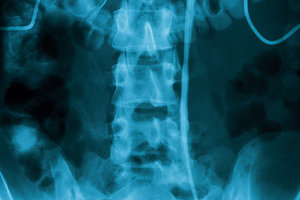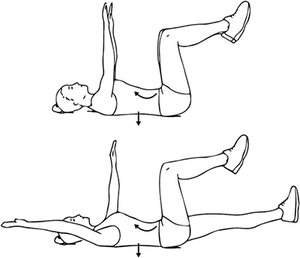The first two articles in this five-article series [see article #1 in the December 2017 issue and article #2 in the February 2018 issue] reviewed McGill's approach in developing lumbar and core stability by maintaining neutral lumbar spine in rehab and in ADLs.
Flexion-Based Exercises
First, we need to differentiate between using flexion-based activities for developing core stability with using lumbar flexion to reduce posterior element irritation / compression. For example, James Cox, DC, has treated disc syndromes with flexion-based treatment for more than 30 years and Williams' flexion exercises have been a mainstay of lumbar rehabilitation since the 1930s.
 More recently, Carlo Ammendolia, DC, PhD, has extensively researched the use of flexion protocols in the management of lumbar stenosis and his results are outstanding. He has standardized the treatment of lumbar stenosis with a combination of flexion-based mobility and stability exercises specifically for lumbar stenosis, and the results are quite impressive.
More recently, Carlo Ammendolia, DC, PhD, has extensively researched the use of flexion protocols in the management of lumbar stenosis and his results are outstanding. He has standardized the treatment of lumbar stenosis with a combination of flexion-based mobility and stability exercises specifically for lumbar stenosis, and the results are quite impressive.
The rationale for flexion principles in lumbar spine rehabilitation is to reduce the posterior element neurovascular compression / irritation. Flexion distracts the facets, and decompresses the nerve root and neurovascular bundle, which are generally favorable outcomes in treating the lumbar spine. Since many sufferers of low back pain find relief with both active and passive lumbar flexion, it is logical that developing core stability and strength with lumbar flexion will also be beneficial. Hence, Williams' flexion exercises, which include single- and double-knee to chest stretches, as well as the abdominal curl-up, are common exercises for low back pain patients.
Appropriate Candidates for Flexion-Based Exercises
As a general guideline, patients with the following conditions are appropriate candidates for flexion-oriented exercises:
- Lumbar degenerative disc disease / spondylosis
- Spinal stenosis
- Spondylolisthesis
- Sciatica (secondary to spondylosis, stenosis or spondylolisthesis)
- Disc syndromes (Note: MDT extension protocols are also well-referenced in the literature for lumbar disc treatment)
- Facet imbrication (secondary to hyperlordosis)
Abdominal Hollowing
 FIG 1 Abdominal hollowing combined with lumbar spine flattening.
It is commonly accepted that a primary objective in developing lumbar spine stability involves activation and strengthening of the intrinsic core and multifidi muscle groups. Furthermore, current EMG studies indicate that developing strength in these muscles is best achieved through co-contraction of the muscles as a group, since isolated strengthening cannot be readily achieved.
FIG 1 Abdominal hollowing combined with lumbar spine flattening.
It is commonly accepted that a primary objective in developing lumbar spine stability involves activation and strengthening of the intrinsic core and multifidi muscle groups. Furthermore, current EMG studies indicate that developing strength in these muscles is best achieved through co-contraction of the muscles as a group, since isolated strengthening cannot be readily achieved.
While McGill uses bracing for initiating this process, "abdominal hollowing" (commonly with flattening of the lumbar curve) can also be used to strengthen the intrinsic core muscles.
Abdominal hollowing is best described as drawing the navel in and up toward the diaphragm. The objective is to strengthen the transverse abdominus (TA) and intrinsic core muscles. It is commonly performed while lying on a pressure gauge as a biofeedback device to ensure adequate TA contraction.
 FIG 2 Dead bug progression: hold abdominal hollowing and a flat back.
EMG studies have shown that the increased stiffness from abdominal hollowing is significantly less when compared to neutral bracing due to decreased activation of the remainder of the abdominal wall musculature. However, abdominal hollowing has been shown to cause sufficient inhibition of the erector spinae, which makes its use beneficial in the early stages of lumbar spine rehabilitation, as the erectors are often shortened and weak. This concept also fits into Janda's lower crossed postural distortion.
FIG 2 Dead bug progression: hold abdominal hollowing and a flat back.
EMG studies have shown that the increased stiffness from abdominal hollowing is significantly less when compared to neutral bracing due to decreased activation of the remainder of the abdominal wall musculature. However, abdominal hollowing has been shown to cause sufficient inhibition of the erector spinae, which makes its use beneficial in the early stages of lumbar spine rehabilitation, as the erectors are often shortened and weak. This concept also fits into Janda's lower crossed postural distortion.
Hollowing Progressions
Abdominal hollowing is another core stabilization tool that follows a progression, just as any other stabilization exercise. For example, in the supine position, a common progression would be:
- Knees bent (hook-lying)
- Knees bent with abdominal breathing
- Dead bug position
- Dead bug position (leg motion only)
- Dead bug position (arm motion only)
- Dead bug position with both arm and leg motion
For patients who have difficulty with abdominal hollowing, using a pressure biofeedback device is the needed addition. This can be utilized through all phases of rehabilitation.
Current research indicates that for Janda's lower crossed postural distortions and for patients in the early stages of lumbar spine rehabilitation, abdominal hollowing is a good choice. It can provide some symptom relief, kinesthetic awareness, motor control education, and early increased activation of the TA and multifidi during the acute phase. However, once an individual progresses to postures that involve weight bearing, utilization of neutral spine bracing may be better to enhance multiplanar stability and functional movement patterns.
Essentially, abdominal hollowing and neutral spine bracing allow for local stability as a preparation toward the progression to functional, comprehensive spinal stability.
The introduction of active care for the management of acute and chronic low back pain is well-referenced and steadily becoming the standard of care. However, the appropriate exercises need to be introduced, taught properly and progressed thoughtfully to achieve the patient's functional goals. Thoughtful chiropractic rehabilitation addresses the whole kinetic chain, lifestyle, muscular imbalances, as well as the subluxation complex, which accounts for the excellent response our patients achieve. Now it is up to you to own it.
Editor's Note: Videos of the exercises discussed in this article and their progressions can be found on Dr. DeFabio's YouTube channel (www.YouTube/DrDeFabio), and additional rehab tips are available through his website, www.DCDifference.com. Dr. DeFabio's next article will cover the concept of mobility vs. stability in the lumbopelvic hip complex as it relates to lumbar spine rehabilitation.
References
- Ammendolia C. Degenerative lumbar spinal stenosis and its imposters: three case studies. JCCA, 2014;58(3):312-319.
- Kahlaee AH, Ghamkhar L, Arab AM. Effect of the abdominal hollowing and bracing maneuvers on activity pattern of the lumbopelvic muscles during prone hip extension in subjects with or without chronic low back pain: a preliminary study. JMPT, 2017 Feb;40(2):106-117.
- Kim MH, Oh JS. Effects of performing an abdominal hollowing exercise on trunk muscle activity during curl-up exercise on an unstable surface. J Phys Ther Sci, 2015 Feb;27(2):501-17.
- Tayashiki K, Takai Y, Maeo S, Kanehisa H. Intra-abdominal pressure and trunk muscular activities during abdominal bracing and hollowing. Int J Sports Med, 2016 Feb;37(2):134-43.
Click here for more information about Donald DeFabio, DC, DACBSP, DABCO.





